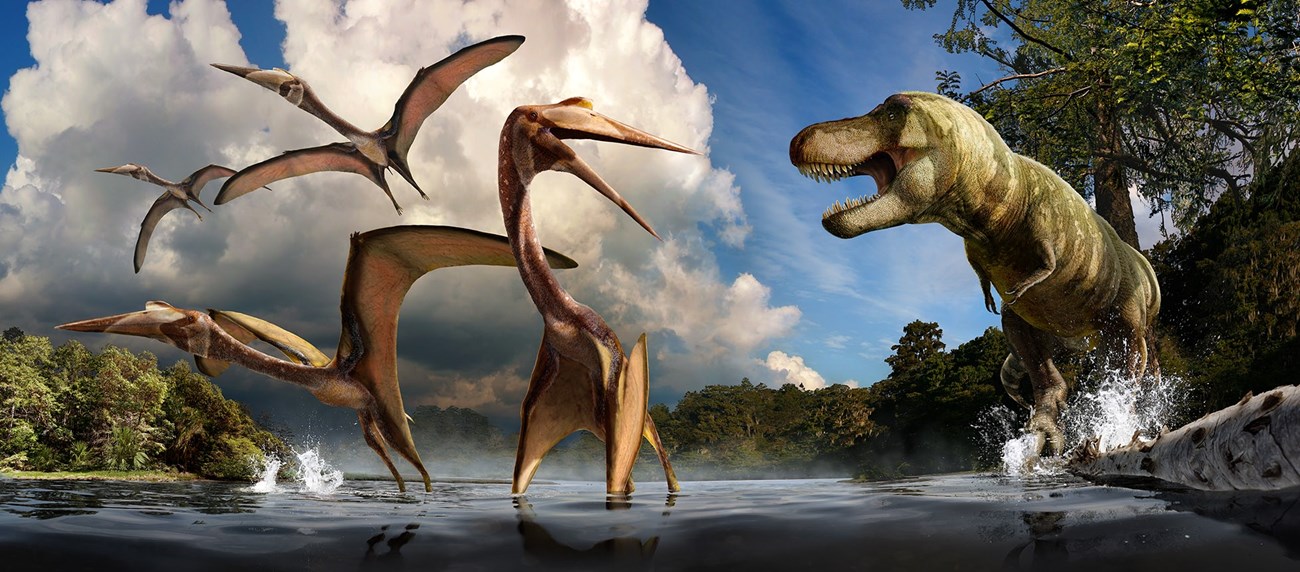Part of a series of articles titled Park Paleontology News - Vol. 09, No. 1, Spring 2017.
Article • Park Paleontology News - Vol. 09, No. 1, Spring 2017
Fossil Discovery Exhibit at Big Bend National Park

Photo by Don Corrick
This self-guided exhibit was designed to feature four ancient ecosystems that make up the park’s diverse geologic and paleontological history. The storyline is driven by Big Bend’s position relative to the Western Interior Seaway that spanned North America during the Cretaceous Period and by changes to the seaway during geologic time.
The first display in the exhibit focuses on Big Bend’s submerged past: during the Early Cretaceous (130 million years ago), Big Bend National Park’s location was underwater. The warm, shallow waters of the Western Interior Seaway supported a diverse assemblage of marine organisms including mosasaurs and the tarpon-like fish, Xiphactinus. The thick layers of limestone deposited at this time have also yielded fossils of ammonites, sea turtles, sharks, sea urchins, oysters, and snails. Among the important scientific discoveries from this time period is evidence of what may be the earliest mosasaurs in North America.
The exhibit then transitions to a coastal floodplain environment during the Late Cretaceous (83-72 million years ago). At this time the Big Bend area was on the shoreline of the Western Interior Seaway, creating habitats such as estuaries and swamps. Horned dinosaurs (Agujaceratops) and armored dinosaurs (Edmontonia) were preyed upon by giant alligators (Deinosuchus) and tyrannosaurs (Teratophoneus). Notable discoveries in the park from this time period include a herd of Agujaceratops dinosaurs and renowned paleontologist Barnum Brown’s discovery of the giant alligatoroid Deinosuchus.
The next display in the exhibit features the inland floodplain environment, representing a time when Big Bend was crossed by rivers and forests about 72 million years ago. The Western Interior Seaway was shrinking, and the coastline had moved several hundred miles to the east. The wildlife of the inland floodplain was dominated by dinosaurs, such as the long-necked sauropod Alamosaurus and the duck-billed hadrosaurs. Big Bend also has evidence of a southern cousin of Tyrannosaurus rex that is as large as the biggest T. rex ever found. On display is the enormous skull of Bravoceratops, a new species of horned dinosaur that was discovered in Big Bend in 2013— the Fossil Discovery Exhibit is currently the only place where this fossil species can be seen. The inland floodplain also yielded Big Bend’s most famous fossil, the giant pterosaur Quetzalcoatlus which is the largest known flying creature of all time.

Mural by Julius Csotonyi and Alexandra Lefort.
The final display interprets the volcanic highland environment of the Cenozoic Era, covering the past 65 million years. During this time, mammals flourished and diversified. The park’s fossil record includes saber-toothed cats, primitive dogs, early lemur-like primates, huge brontotheres, rhino relatives, and mammoths. Most of the park’s volcanic activity occurred during this time as well, and the mural in the display dramatically shows an erupting volcano in the background. After seeing the mammal display and getting a final resource protection message, visitors exit the structure and can take a short path to the site of the mammal fossil quarries of the original Fossil Bone Exhibit.

Photo by Don Corrick
This open air, unstaffed exhibit is open to the public during daylight hours, and nearby is a shaded picnic area with fossil-themed play structures for kids. The exhibit shelter is designed to be sustainable and low-maintenance, and its solar power and water catchment allow it to be completely off of the utility grid. The unpainted, rusty red color helps the structure blend into the desert landscape, and its low profile allows it to remain out of sight behind a nearby ridge.
Funds for the Fossil Discovery Exhibit were raised by the Big Bend Conservancy and included a Centennial grant from the NPS. Thanks to the generosity of the donors, Big Bend National Park now looks forward to inspiring new generations and sharing the remarkable diversity of this park, both with present day plants and animals, as well as those of ages past.
Last updated: April 22, 2020







